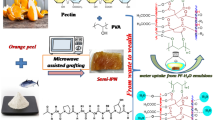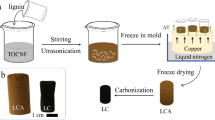Abstract
In the current study, Zeolitic Imidazole Framework-8 (ZIF-8) was in situ grown on the surface of cellulose fibers and the ZIF-8@cellulose composite aerogels were fabricated by a freeze-drying method. The flame-retardant, thermal and mechanical characteristics of the cellulose-based aerogels were investigated. SEM images indicated that ZIF-8 was evenly deposited on the surface of the cellulose fibers in the aerogel owing to formation of hydrogen bonding with cellulose molecules. The addition of ZIF-8 enhanced thermal stability and flame retardancy of the host cellulose aerogel. The peak of heat release rate of the ZIF-8@cellulose-3 composite aerogel exhibited a drastic decline from 128 W g−1 to 63 W g−1 and the total heat release from 25.9 kJ g−1 to 14.8 kJ g−1. In the UL-94 vertical burning test, the samples showed self-extinguishing behavior. Additionally, ZIF-8 induced a dramatic enhancement in the mechanical properties of the host cellulose. Specifically, the compressive stress of the ZIF-8@cellulose composite aerogel showed a significant increase from 0.45 to 34.80 MPa. Moreover, the ZIF-8@cellulose composite aerogel can selectively remove the organic pollutants from water and adsorb a wide range of liquid oils with considerable capacities. The current study presented a feasible approach to synthesis of strong and flame-retardant cellulose-based aerogels for waste water purification.















Similar content being viewed by others
References
Alongi J, Malucelli G (2015) Cotton flame retardancy: state of the art and future perspectives. RSC Adv 5:24239–24263
Bi HC, **e X, Yin KB, Zhou YL, Wan S, He LB et al (2012) Spongy graphene as a highly efficient and recyclable sorbent for oils and organic solvents. Adv Funct Mater 22:4421–4425
Cai J, Liu SL, Feng J, Kimura S, Wada M, Kuga S et al (2012) Cellulose-silica nanocomposite aerogels by in situ formation of silica in cellulose gel. Angew Chem Int Ed 51:2076–2079
French AD (2014) Idealized powder diffraction patterns for cellulose polymorphs. Cellulose 21:885–896
Furukawa H, Cordova KE, O'Keeffe M, Yaghi OM (2013) The chemistry and applications of metal-organic frameworks. Science 341:1230444
Gu PC, Zhang S, Li X, Wang XX, Wen T, Jehan R et al (2018) Recent advances in layered double hydroxide-based nanomaterials for the removal of radionuclides from aqueous solution. Environ Pollut 240:493–505
Guo WW, Wang X, Zhang P, Liu JJ, Song L, Hu Y (2018) Nano-fibrillated cellulose-hydroxyapatite based composite foams with excellent fire resistance. Carbohyd Polym 195:71–78
Guo WW, Hu YX, Wang X, Zhang P, Song L, **ng WY (2019a) Exceptional flame-retardant cellulosic foams modified with phosphorus-hybridized graphene nanosheets. Cellulose 26:1247–1260
Guo WW, Kalali EN, Wang X, **ng WY, Zhang P, Song L, Hu Y (2019b) Processing bulk natural bamboo into a strong and flame-retardant composite material. Ind Crop Prod 138:111478
Han YY, Zhang XX, Wu XD, Lu CH (2015) Flame retardant, heat insulating cellulose aerogels from waste cotton fabrics by in situ formation of magnesium hydroxide nanoparticles in cellulose gel nanostructures. ACS Sustain Chem Eng 3:1853–1859
Huang JK, Yan ZF (2018) Adsorption mechanism of oil by resilient graphene aerogels from oil-water emulsion. Langmuir 34:1890–1898
Jafari AJ, Alahabadi A, Saghi MH, Rezai Z, Rastegar A, Zamani MS et al (2019) Adsorptive removal of phenol from aqueous solutions using chemically activated rice husk ash: equilibrium, kinetic, and thermodynamic studies. Desalin Water Treat 158:233–244
** H, Li YS, Liu XL, Ban YJ, Peng Y, Jiao WM et al (2015) Recovery of HMF from aqueous solution by zeolitic imidazolate frameworks. Chem Eng Sci 124:170–178
Kaya M (2017) Super absorbent, light, and highly flame retardant cellulose-based aerogel crosslinked with citric acid. J Appl Polym Sci 134:45315
Khan E, Virojnagud W, Ratpukdi T (2004) Use of biomass sorbents for oil removal from gas station runoff. Chemosphere 57:681–689
Koklukaya O, Carosio F, Waberg L (2017) Superior flame-resistant cellulose nanofibril aerogels modified with hybrid layer-by-layer coatings. ACS Appl Mater Interfaces 9:29082–29092
Li A, Sun HX, Tan DZ, Fan WJ, Wen SH, Qing XJ et al (2011) Superhydrophobic conjugated microporous polymers for separation and adsorption. Energ Environ Sci 4:2062–2065
Li ZY, Shao L, Hu WB, Zheng TT, Lu LB, Cao Y et al (2018) Excellent reusable chitosan/cellulose aerogel as an oil and organic solvent absorbent. Carbohyd Polym 191:183–190
Likon M, Remskar M, Ducman V, Svegl F (2013) Populus seed fibers as a natural source for production of oil super absorbents. J Environ Manage 114:158–167
Lillo-Rodenas MA, Cazorla-Amoros D, Linares-Solano A (2005) Behaviour of activated carbons with different pore size distributions and surface oxygen groups for benzene and toluene adsorption at low concentrations. Carbon 43:1758–1767
Liu ZW, Tang YF, Zhao K, Zhang Q (2019) Superhydrophobic SiO2 micro/nanofibrous membranes with porous surface prepared by freeze electrospinning for oil adsorption. Colloid Surface A 568:356–361
Lv SW, Liu JM, Wang ZH, Ma H, Li CY, Zhao N et al (2019) Recent advances on porous organic frameworks for the adsorptive removal of hazardous materials. J Environ Sci-China 80:169–185
Mi HY, **g X, Huang HX, Peng XF, Turng LS (2018) Superhydrophobic graphene/cellulose/silica aerogel with hierarchical structure as superabsorbers for high efficiency selective oil absorption and recovery. Ind Eng Chem Res 57:1745–1755
Nabipour H, Sadr MH, Bardajee GR (2017) Synthesis and characterization of nanoscale zeolitic imidazolate frameworks with ciprofloxacin and their applications as antimicrobial agents. New J Chem 41:7364–7370
Nadar SS, Rathod VK (2018) Encapsulation of lipase within metal-organic framework (MOF) with enhanced activity intensified under ultrasound. Enzyme Microb Tech 108:11–20
Ruan D, Zhang LN, Mao Y, Zeng M, Li XB (2004) Microporous membranes prepared from cellulose in NaOH/thiourea aqueous solution. J Membrane Sci 241:265–274
Sakthivel T, Reid DL, Goldstein I, Hench L, Seal S (2013) Hydrophobic High Surface Area Zeolites Derived from Fly Ash for Oil Spill Remediation. Environ Sci Technol 47:5843–5850
Scheirs J, Camino G, Tumiatti W (2001) Overview of water evolution during the thermal degradation of cellulose. Eur Polym J 37:933–942
Shen J, Zhang P, Song L, Li J, Ji B, Li J, Chen L (2019) Polyethylene glycol supported by phosphorylated polyvinyl alcohol/graphene aerogel as a high thermal stability phase change material. Compos Part B: Eng 179:107545
Shi JJ, Lu LB, Guo WT, Sun YJ, Cao Y (2013a) An environment-friendly thermal insulation material from cellulose and plasma modification. J Appl Polym Sci 130:3652–3658
Shi XW, Hu YL, Tu K, Zhang LN, Wang H, Xu J et al (2013b) Electromechanical polyaniline-cellulose hydrogels with high compressive strength. Soft Matter 9:10129–10134
Shi XW, Dai X, Cao Y, Li JW, Huo CG, Wang XL (2017) Degradable poly(lactic acid)/metal-organic framework nanocomposites exhibiting good mechanical, flame retardant, and dielectric properties for the fabrication of disposable electronics. Ind Eng Chem Res 56:3887–3894
Siqueira G, Bras J, Dufresne A (2010) Cellulosic bionanocomposites: A review of preparation, properties and applications. Polymers 2:728–765
Wang X, Hu Y, Song L, **ng WY, Lu HD, Lv P, Jie GX (2010) Flame retardancy and thermal degradation mechanism of epoxy resin composites based on a DOPO substituted organophosphorus oligomer. Polymer 51:2435–2445
Wang X, Hu Y, Song L, **ng WY, Lu HD (2011) Thermal degradation mechanism of flame retarded epoxy resins with a DOPO-substitued organophosphorus oligomer by TG-FTIR and DP-MS. J Anal Appl Pyrol 92:164–170
Wang D, McLaughlin E, Pfeffer R, Lin YS (2012) Adsorption of oils from pure liquid and oil-water emulsion on hydrophobic silica aerogels. Sep Purif Technol 99:28–35
Wang Z, Ma HY, Chu B, Hsiao BS (2017) Super-hydrophobic polyurethane sponges for oil absorption. Sep Sci Technol 52:221–227
Wang G, Qin X, Shen J, Zhang Z, Han D, Jiang C (2019a) Quantitative analysis of microscopic structure and gas seepage characteristics of low-rank coal based on CT three-dimensional reconstruction of CT images and fractal theory. Fuel 256:115900
Wang G, Jiang C, Shen J, Han D, Qin X (2019b) Deformation and water transport behaviors study of heterogenous coal using CT-based 3D simulation. Int J Coal Geol 211:103204
Wang G, Shen J, Liu S, Jiang C, Qin X (2019c) Three-dimensional modeling and analysis of macro-pore structure of coal using combined X-ray CT imaging and fractal theory. Int J Rock Mech Min 123:104082
Wang H, Wang CC, Liu S, Chen L, Yang SD (2019d) Superhydrophobic and superoleophilic graphene aerogel for adsorption of oil pollutants from water. RSC Adv 9:8569–8574
Wei G, Miao YE, Zhang C, Yang Z, Liu ZY, Tjiu WW et al (2013) Ni-doped graphene/carbon cryogels and their applications as versatile sorbents for water purification. ACS Appl Mater Interfaces 5:7584–7591
Xu WZ, Wang XL, Liu YC, Li W, Chen R (2018) Improving fire safety of epoxy filled with graphene hybrid incorporated with zeolitic imidazolate framework/layered double hydroxide. Polym Degrad Stabil 154:27–36
Yang C, Kaipa U, Mather QZ, Wang XP, Nesterov V, Venero AF et al (2011) Fluorous metal-organic frameworks with superior adsorption and hydrophobic properties toward oil spill cleanup and hydrocarbon storage. J Am Chem Soc 133:18094–18097
Yang L, Mukhopadhyay A, Jiao YC, Yong Q, Chen L, **ng YJ et al (2017) Ultralight, highly thermally insulating and fire resistant aerogel by encapsulating cellulose nanofibers with two-dimensional MoS2. Nanoscale 9:11452–11462
Zhang C, Yang DY, Zhang T, Qiu FX, Dai YT, Xu JC et al (2017) Synthesis of MnO2/poly(n-butylacrylate-co-butyl methacrylate-co-methyl methacrylate) hybrid resins for efficient oils and organic solvents absorption. J Clean Prod 148:398–406
Zhao SY, Malfait WJ, Guerrero-Alburquerque N, Koebel MM, Nystrom G (2018) Biopolymer aerogels and foams: chemistry, properties, and applications. Angew Chem Int Ed 57:7580–7608
Acknowledgments
We gratefully acknowledge financial support from the National Natural Science Foundation of China (Grant No. 21604081), Anhui Provincial Natural Science Foundation (Grant No. 1908085J20) and the CAS President’s International Fellowship for Postdoctoral Researchers (Grant No.: 2019PE0014).
Author information
Authors and Affiliations
Corresponding authors
Additional information
Publisher's Note
Springer Nature remains neutral with regard to jurisdictional claims in published maps and institutional affiliations.
Rights and permissions
About this article
Cite this article
Nabipour, H., Nie, S., Wang, X. et al. Highly flame retardant zeolitic imidazole framework-8@cellulose composite aerogels as absorption materials for organic pollutants. Cellulose 27, 2237–2251 (2020). https://doi.org/10.1007/s10570-019-02860-9
Received:
Accepted:
Published:
Issue Date:
DOI: https://doi.org/10.1007/s10570-019-02860-9




